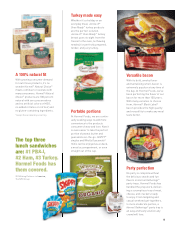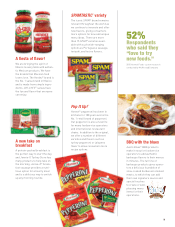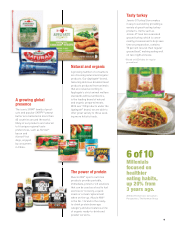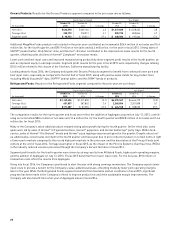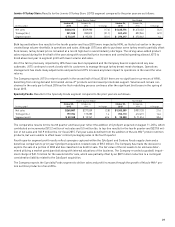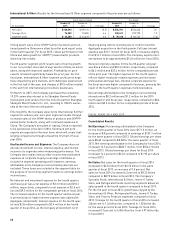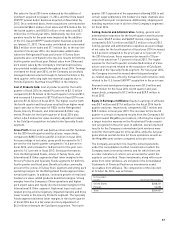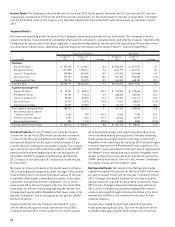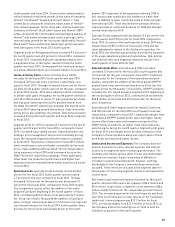Hormel Foods 2015 Annual Report Download - page 17
Download and view the complete annual report
Please find page 17 of the 2015 Hormel Foods annual report below. You can navigate through the pages in the report by either clicking on the pages listed below, or by using the keyword search tool below to find specific information within the annual report.15
In conducting the initial qualitative assessment, the Company
analyzes actual and projected growth trends for net sales,
gross margin, and segment profi t for each reporting unit, as
well as historical performance versus plan and the results
of prior quantitative tests performed. Additionally, each
reporting unit assesses critical areas that may impact their
business, including macroeconomic conditions and the related
impact, market related exposures, any plans to market all or a
portion of their business, competitive changes, new or discon-
tinued product lines, changes in key personnel, or any other
potential risks to their projected fi nancial results.
If performed, the quantitative goodwill impairment test is a
two-step process performed at the reporting unit level. First,
the fair value of each reporting unit is compared to its corre-
sponding carrying value, including goodwill. The fair value of
each reporting unit is estimated using discounted cash fl ow
valuations (Level 3), which incorporate assumptions regarding
future growth rates, terminal values, and discount rates.
The estimates and assumptions used consider historical
performance and are consistent with the assumptions used in
determining future profi t plans for each reporting unit, which
are approved by the Company’s Board of Directors. If the fi rst
step results in the carrying value exceeding the fair value of
any reporting unit, then a second step must be completed in
order to determine the amount of goodwill impairment that
should be recorded. In the second step, the implied fair value
of the reporting unit’s goodwill is determined by allocating
the reporting unit’s fair value to all of its assets and liabilities
other than goodwill in a manner similar to a purchase price
allocation. The implied fair value of the goodwill that results
from the application of this second step is then compared
to the carrying amount of the goodwill and an impairment
charge is recorded for the difference.
During fi scal 2015, 2014, and 2013, as a result of the qualitative
testing performed, no impairment charges were recorded other
than for the Company’s assets held for sale in fi scal 2015.
In conducting the annual impairment test for its indefi -
nite-lived intangible assets, the Company fi rst performs a
qualitative assessment to determine whether it is more likely
than not (> 50% likelihood) that an indefi nite-lived intangible
asset is impaired. If the Company concludes that this is the
case, then a quantitative test for impairment must be per-
formed. Otherwise, the Company does not need to perform a
quantitative test.
In conducting the initial qualitative assessment, the Company
analyzes growth rates for historical and projected net
sales and the results of prior quantitative tests performed.
Additionally, the Company assesses critical areas that may
impact its intangible assets or the applicable royalty rates to
determine if there are factors that could indicate impairment
of the asset.
If performed, the quantitative impairment test compares the
fair value and carrying value of the indefi nite-lived intangible
asset. The fair value of indefi nite-lived intangible assets is
primarily determined on the basis of estimated discounted
value, using the relief from royalty method (Level 3), which
incorporates assumptions regarding future sales projections
The Company offers various sales incentives to customers
and consumers. Incentives that are offered off-invoice include
prompt pay allowances, will call allowances, spoilage allow-
ances, and temporary price reductions. These incentives are
recognized as reductions of revenue at the time title passes.
Coupons are used as an incentive for consumers to purchase
various products. The coupons reduce revenues at the time
they are offered, based on estimated redemption rates.
Promotional contracts are performed by customers to pro-
mote the Company’s products to consumers. These incentives
reduce revenues at the time of performance through direct
payments and accrued promotional funds. Accrued promo-
tional funds are unpaid liabilities for promotional contracts
in process or completed at the end of a quarter or fi scal year.
Promotional contractual accruals are based on agreements
with customers for defi ned performance. The liability relating
to these agreements is based on a review of the outstanding
contracts on which performance has taken place but for which
the promotional payments relating to such contracts remain
unpaid as of the end of the fi scal year. The level of customer
performance and the historical spend rate versus contracted
rates are signifi cant estimates used to determine these
liabilities.
Inventory Valuation: The Company values its pork inventories
at the lower of cost or USDA market prices (primal values).
When the carcasses are disassembled and transferred from
primal processing to various manufacturing departments, the
primal values, as adjusted by the Company for product specifi -
cations and further processing, become the basis for calculat-
ing inventory values. Turkey raw materials are represented by
the deboned meat quantities. The Company values these raw
materials using a concept referred to as the “meat cost pool.”
The meat cost pool is determined by combining the cost to
grow turkeys with processing costs, less any net sales revenue
from by-products created from the processing and not used
in producing Company products. The Company has developed
a series of ratios using historical data and current market
conditions (which themselves involve estimates and judgment
determinations by the Company) to allocate the meat cost
pool to each meat component. Substantially all inventoriable
expenses, meat, packaging, and supplies are valued by the
average cost method.
Goodwill and Other Indefi nite-Lived Intangibles: Indefi nite-
lived intangible assets are originally recorded at their esti-
mated fair values at date of acquisition and the residual of the
purchase price is recorded to goodwill. Goodwill and other
indefi nite-lived intangible assets are allocated to reporting
units that will receive the related sales and income. Goodwill
and indefi nite-lived intangible assets are tested annually for
impairment, or more frequently if impairment indicators arise.
In conducting the annual impairment test for goodwill, the
Company fi rst performs a qualitative assessment to deter-
mine whether it is more likely than not (> 50% likelihood) that
the fair value of any reporting unit is less than its carrying
amount. If the Company concludes this is the case, then a
two-step quantitative test for goodwill impairment is per-
formed for the appropriate reporting units. Otherwise, the
Company concludes no impairment is indicated and does not
perform the two-step test.


